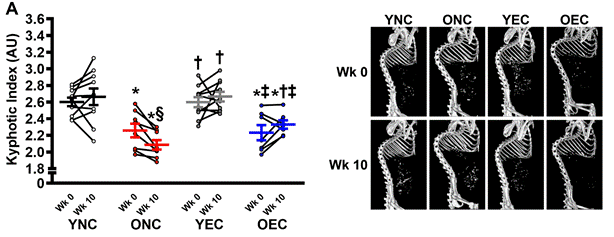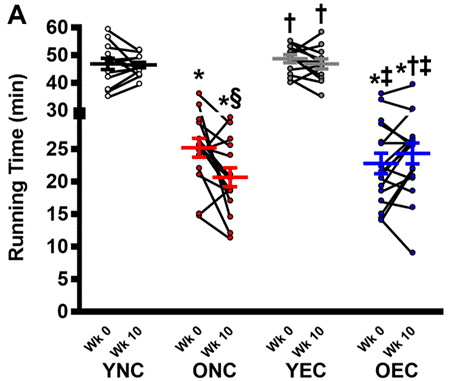Hyaluronan Supplement Prevents Frailty with Advanced Age, Suggests New Study
A supplement containing high-molecular-weight hyaluronan (HMW-HA) prevents an age-related decline in aspects of physical function, such as running capacity, in old mice.
Highlights
- Treating old mice with a supplement containing HMW-HA for 10 weeks increased the thickness of the glycocalyx, a layer of carbohydrates on the outer surface of many cells.
- Old mice given the HMW-HA supplement also exhibited lower frailty, as measured with an assessment of spinal curvature.
- Moreover, HMW-HA-supplemented old mice displayed an improved maximal exercise capacity, as measured with running time to exhaustion.
High-molecular-weight hyaluronan (HMW-HA), a complex carbohydrate found in a gel-like, carbohydrate-rich layer lining various tissues (called the glycocalyx), has gained notoriety for contributing, in part, to the notably prolonged lifespans of naked mole rats. What distinguishes HMW-HA from other forms of hyaluronan, such as low-molecular-weight hyaluronan, is that it has a greater mass.
As such, naked mole rats live around 30 years on average, an extensive duration compared to other rodents of similar size, such as mice, which live for six months to two years. Furthermore, research has shown that HMW-HA produced in some cells of naked mole rats is about five times the mass of that produced in mice and humans and plays a key role in their extraordinary longevity.
Regarding the glycocalyx, HMW-HA is a major component of it. Accordingly, research has demonstrated that the mass of hyaluronan shifts from HMW-HA to low-molecular-weight hyaluronan with advanced age in humans, suggesting that hyaluronan mass declines with age. This shift coincides with an age-related deterioration of cardiovascular function and declining physical function (often referred to as frailty).
Some scientists have proposed the notion that a deteriorating glycocalyx lining vascular cells with advanced age leads to cardiovascular dysfunction and may precipitate cardiovascular disease. Moreover, since a well-functioning heart and vasculature are necessary for muscles to receive nutrients and oxygen, Donato and colleagues from the University of Utah proposed the idea that a deteriorating vascular glycocalyx with advanced age may contribute to age-related loss of physical function and accelerated frailty. They also hypothesized that a supplement containing the constituent component of the glycocalyx, HMW-HA, with a mass similar to that present in naked mole rats, may improve the thickness of the vascular glycocalyx, enhance vascular function, and prevent age-related frailty.
As published in an Aging article, Donato and colleagues showed that reducing the expression of a gene that codes for an enzyme that produces hyaluronan by 75% impairs maximal exercise capacity and energy production in the cell’s powerhouse (mitochondria) of mice, providing evidence of an association between hyaluronan levels and physical performance. Confirming this association, old mice treated with an HMW-HA supplement for 10 weeks displayed improved glycocalyx thickness and preserved physical function, while non-treated old mice showed significant reductions in physical capacity. Importantly, old mice treated with the HMW-HA supplement also exhibited improvements in running distance before exhaustion and mitochondrial function. These findings suggest that, by enhancing vascular glycocalyx thickness and cardiovascular function, HMW-HA supplementation improves physical function capacity and prevents frailty with advanced age.
“Taken together, these findings provide direct evidence of a role for HMW-HA in the modulation of exercise capacity,” say Donato and colleagues.
High-Molecular-Weight Hyaluronan Increases Glycocalyx Thickness, Improves Exercise Capacity, and Reduces Frailty
In more detail regarding to these findings, to determine whether a link between hyaluronan synthesis, glycocalyx thickness, and physical function exists, Donato and colleagues genetically engineered mice to have a 75% reduction in the expression of a gene coding for a hyaluronan-synthesizing enzyme. Interestingly, these genetically engineered mice exhibited reduced muscle vasculature glycocalyx thickness. Moreover, these mice showed lower maximal exercise capacity, as determined by running time to exhaustion, compared to mice without reduced hyaluronan-synthesizing enzyme gene expression. These data provide evidence that reduced hyaluronan synthesis lowers muscle vascular glycocalyx thickness and impedes physical function.
After finding evidence for this link, Donato and colleagues next sought to find how HMW-HA supplementation affects glycocalyx thickness and physical fitness with advanced age. Interestingly, HMW-HA supplementation significantly increased glycocalyx thickness in old mice. The researchers also applied a measurement of age-related frailty that uses an assessment of the curvature of the spine to assess physical function. According to scores from this assessment, HMW-HA treatment indeed prevented age-associated frailty in old mice. These results suggest that HMW-HA increases glycocalyx thickness and improves aspects of physical function to prevent an age-related physical deterioration that leads to frailty.

To find whether supplementing old mice with HMW-HA does indeed enhance their physical functioning capacity, Donato and colleagues measured their maximal exercise capacity. One indicator of maximal exercise capacity is running time to exhaustion, where mice are subjected to a forced-running test on a treadmill. Thus, using the running time to exhaustion test, Donato and colleagues found that running scores significantly improved after 10 weeks of HMW-HA supplementation in old mice. In comparison, non-treated old mice showed a considerably reduced running capacity using this test over the course of 10 weeks. This finding suggests that HMW-HA supplementation improves maximal exercise capacity with advanced age, which also suggests HMW-HA counteracts frailty, since a reduced maximal exercise capacity has been associated with age-related frailty.

A Possibility that HMW-HA Directly Improves Skeletal Muscle Function
This study by Donato and colleagues provides data suggesting that HMW-HA supplementation improves glycocalyx thickness and prevents frailty with advanced age. One caveat to this idea is that muscle fibers contain a glycocalyx containing hyaluronan. Thus, while HMW-HA supplementation improves glycocalyx thickness in blood vessels supplying the muscle, it is also possible that HMW-HA supplementation improves muscle fiber glycocalyxes to enhance muscle function and prevent frailty.
This is important because Donato and colleagues hypothesized that improved cardiovascular function from increasing glycocalyx thickness and vascular function may improve blood flow and nutrient delivery to muscles, thus preventing age-related frailty. While the data support this idea, in part, the notion that HMW-HA supplementation improves muscle fiber glycocalyx thickness and overall muscle function to prevent frailty cannot be ruled out.
Previous research has shown that treating old mice with a supplement containing HMW-HA alleviates age-related dysfunction of blood vessels, which may enhance cardiovascular function and improve nutrient delivery and blood flow to muscles. However, future research should also seek to uncover whether HMW-HA supplementation also directly improves muscle function, independently of effects on cardiovascular function.
Furthermore, some research also suggests that HMW-HA has anti-cancer properties. In line with this idea, HMW-HA may have multiple pro-longevity effects, aside from preventing age-related frailty. Along those lines, human trials are underway or completed without released data, testing HMW-HA’s effects in conditions ranging from an eye disease to pain arising from mouth joint disorders. Thus, while researchers are conducting human testing of HMW-HA in mostly non-age-related conditions, in the not-so-distant future, it will be interesting to see data coming out that either supports or refutes the effectiveness of HMW-HA in humans.
If HMW-HA indeed has positive effects on certain facets of human physiology, such as eye function, future human trials should then test whether HMW-HA has broader effects on human physical function, possibly preventing frailty during aging. Along those lines, if HMW-HA has positive influences on multiple physiological systems and alleviates frailty in humans, the possibility looms that it could extend life without a debilitating disease. In this way, using an aspect of the long-lived naked mole rat’s physiology, HMW-HA, could one day translate to improved human longevity, making all the research performed on these creatures worthwhile.
Model: Young, seven-month-old and old, 29-month-old B6D2F1/J mice, roughly equivalent to the human ages of 33 and 79, respectively
Dosage: 37 mg/kg of a supplement in the diet containing glucosamine sulfate, fucoidan, superoxide dismutase, and high-molecular-weight hyaluronan

